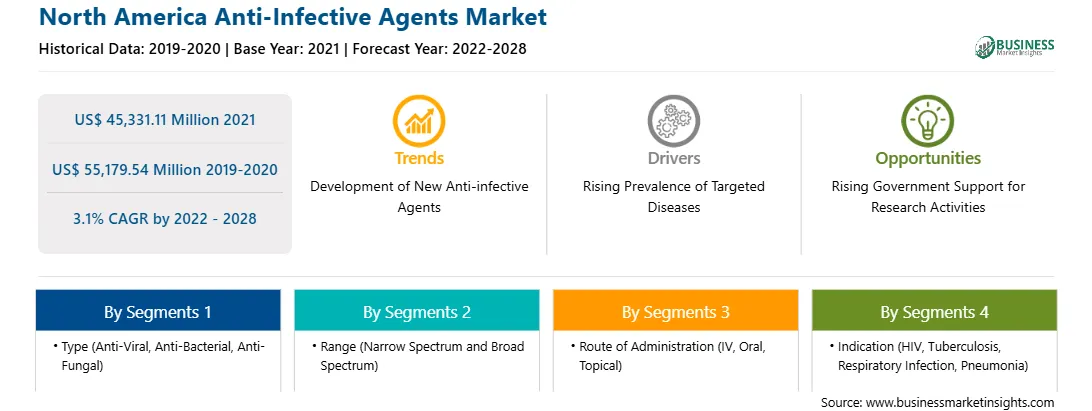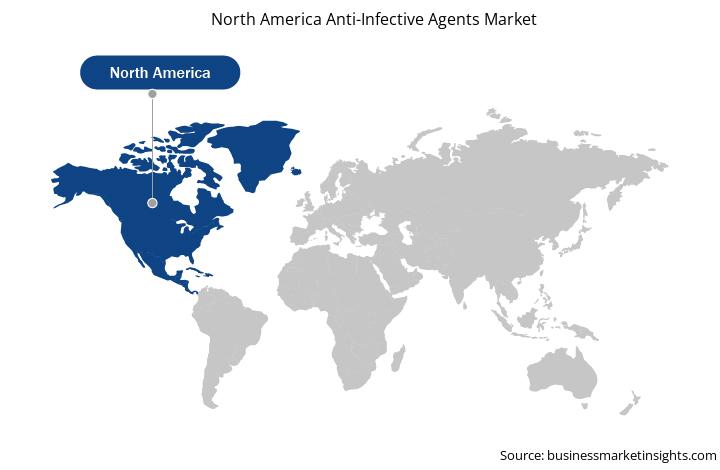The anti-infective agents market in North America is expected to grow from US$ 45,331.11 million in 2021 to US$ 55,179.54 million by 2028. It is estimated to grow at a CAGR of 3.1% from 2022 to 2028.
The increasing prevalence of chronic diseases is a major factor behind the growth of the North America anti-infective agents market. Chronic diseases are conditions that develop over an extended period due to a combination of genetic, physiological, environmental, and behavioral variables. The four primary categories of NCD are diabetes, cancer, chronic respiratory diseases (such as chronic obstructive pulmonary disease and asthma), and cardiovascular disorders (including heart attacks and stroke). The rising prevalence of anti-infective resistance, which has now become a public health issue, poses a hazard to human health. Anti-bacterial, anti-viral, anti-fungal, and anti-parasitic drugs are anti-infectives that work to prevent or treat infections. Antibiotics are chemically derived antimicrobial medications that cure and prevent bacterial illnesses by eradicating or preventing their growth. Azithromycin, clarithromycin, and erythromycin are examples of macrolides, which have historically been the main antibiotic classes, studied for their potential role in the secondary prevention of coronary heart diseases.
The study of cancer genesis has advanced to the cellular and molecular levels due to the rapid growth of contemporary science and technology, particularly biomedicine, in the 20th century. Modern cell biology describes malignancies as a group of biological illnesses distinguished by aberrant cell proliferation. Since every cancer begins in a single cell, cancers are also diseases that include alterations in the structure and function of genetic material. Since cancer cells proliferate, they pass on their malignant activity to their offspring (DNA). In the meantime, cancer formation and incidence are also promoted by the invasive growth and spread of cancer cells. One of the most significant classes of antibiotics with their unique inhibitory effects on malignancies is the anti-cancer class. Several antibiotics' anti-proliferative, pro-apoptotic, and anti-epithelial-mesenchymal-transition (EMT) properties have been employed in the treatment of cancer. Thus, the increasing prevalence of chronic diseases is driving the North America anti-infective agents market.
Vendors can attract new customers and expand their footprints in emerging markets with new features and technologies. This factor is likely to drive the North America anti-infective agents market at a good CAGR during the forecast period.
Strategic insights for the North America Anti-Infective Agents provides data-driven analysis of the industry landscape, including current trends, key players, and regional nuances. These insights offer actionable recommendations, enabling readers to differentiate themselves from competitors by identifying untapped segments or developing unique value propositions. Leveraging data analytics, these insights help industry players anticipate the market shifts, whether investors, manufacturers, or other stakeholders. A future-oriented perspective is essential, helping stakeholders anticipate market shifts and position themselves for long-term success in this dynamic region. Ultimately, effective strategic insights empower readers to make informed decisions that drive profitability and achieve their business objectives within the market. The geographic scope of the North America Anti-Infective Agents refers to the specific areas in which a business operates and competes. Understanding local distinctions, such as diverse consumer preferences (e.g., demand for specific plug types or battery backup durations), varying economic conditions, and regulatory environments, is crucial for tailoring strategies to specific markets. Businesses can expand their reach by identifying underserved areas or adapting their offerings to meet local demands. A clear market focus allows for more effective resource allocation, targeted marketing campaigns, and better positioning against local competitors, ultimately driving growth in those targeted areas.North America Anti-Infective Agents Strategic Insights

North America Anti-Infective Agents Report Scope
Report Attribute
Details
Market size in 2021
US$ 45,331.11 Million
Market Size by 2028
US$ 55,179.54 Million
Global CAGR (2022 - 2028)
3.1%
Historical Data
2019-2020
Forecast period
2022-2028
Segments Covered
By Type
By Range
By Route of Administration
By Indication
By Distribution Channel
Regions and Countries Covered
North America
Market leaders and key company profiles
North America Anti-Infective Agents Regional Insights

North America Anti-Infective Agents Market Segmentation
The North America anti-infective agents market is segmented based on type, range, route of administration, indication, distribution channel, and country. Based on type, the market is segmented into anti-bacterial, anti-viral, anti-fungal, and others. The anti-viral segment is expected to account for the largest market share by the end of 2022.
Based on range, the market is segmented into broad spectrum and narrow spectrum. By the end of 2022, the narrow spectrum segment will likely hold a larger market share.
Based on route of administration, the market is segmented into topical, oral, IV, and others. By the end of 2022, the IV segment is likely to hold the largest market share.
Based on indication, the market is segmented into HIV, tuberculosis, respiratory infection, pneumonia, and others. In 2022, the others segment is projected to hold the largest share of the market.
Based on distribution channel, the market is segmented into hospital pharmacies, specialty pharmacies, e-commerce, and others. By the end of 2022, the hospital pharmacies segment is likely to hold the largest market share.
Based on country, the market is segmented into the US, Canada, and Mexico. The US is expected to hold the largest market share by the end of 2022.
Abbott; Allergan Plc.; Astellas Pharma Inc.; Bayer AG; Boehringer Ingelheim International GmbH; Bristol-Myers Squibb Company; F. Hoffmann-La Roche Ltd.; Gilead Sciences, Inc.; GlaxoSmithKline plc.; Merck & Co., Inc.; and Novartis AG are the leading companies in the North America anti-infective agents market.
The North America Anti-Infective Agents Market is valued at US$ 45,331.11 Million in 2021, it is projected to reach US$ 55,179.54 Million by 2028.
As per our report North America Anti-Infective Agents Market, the market size is valued at US$ 45,331.11 Million in 2021, projecting it to reach US$ 55,179.54 Million by 2028. This translates to a CAGR of approximately 3.1% during the forecast period.
The North America Anti-Infective Agents Market report typically cover these key segments-
The historic period, base year, and forecast period can vary slightly depending on the specific market research report. However, for the North America Anti-Infective Agents Market report:
The North America Anti-Infective Agents Market is populated by several key players, each contributing to its growth and innovation. Some of the major players include:
The North America Anti-Infective Agents Market report is valuable for diverse stakeholders, including:
Essentially, anyone involved in or considering involvement in the North America Anti-Infective Agents Market value chain can benefit from the information contained in a comprehensive market report.